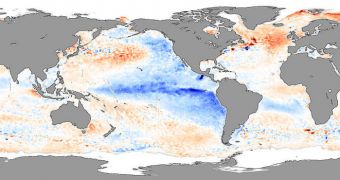According to experts at the US National Oceanic and Atmospheric Administration (NOAA), it would appear that the La Niña phenomenon has stopped in the equatorial waters of the Pacific Ocean.
The NOAA National Centers for Environmental Prediction (NCEP) says that ENSO-neutral conditions have developed in the area, and that the transition to El Niño is set to begin soon. The two phenomena alternate, influencing climate patterns around the world.
ENSO stands for El Niño/La Niña-Southern Oscillation. The new announcement implies that neither of the two events is influencing climate more than the other at this point. These conditions will prevail in the Northern Hemisphere at least until the end of the summer.
The transition from La Niña to ENSO-neutral conditions took place in May, the investigators say. This is evidenced by a new map, which indicates only small sea surface temperature (SST) anomalies across the equatorial Pacific Ocean.
Experts say that both the atmosphere and the waters in the Pacific areas continue to exhibit some traits generally associated with the climate pattern, but add that the intensity of these signals is slowly diminishing and fading away. Soon, they add, the signals will be gone.
“Convection was enhanced over eastern Indonesia and suppressed over the central equatorial Pacific. Also, anomalous low-level easterly and upper-level westerly winds weakened but persisted over the central Pacific,” a NCEP Center for Climate Prediction (CPC) press release reads.
“Collectively, these oceanic and atmospheric anomalies reflect a transition to ENSO-neutral conditions, but with lingering La Niña-like atmospheric impacts, particularly in the global Tropics,” it adds.
While the way things will evolve in the Northern Hemisphere during this summer is rather clear, experts cannot yet predict with any degree of certainty how the shift will affect the Southern Hemisphere through the end of 2011.
The La Niña is a coupled ocean-atmosphere process, which causes sea surface temperature across the equatorial eastern-central Pacific Ocean to drop below normal values by 3 to 5 degrees Celsius. This influences the way in which the large ocean contributes to determining Earth's climate.
El Niño is the exact opposite of La Niña. During the months or years when it prevails, the same region of the Pacific is warmer than usual.

 14 DAY TRIAL //
14 DAY TRIAL //